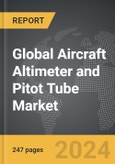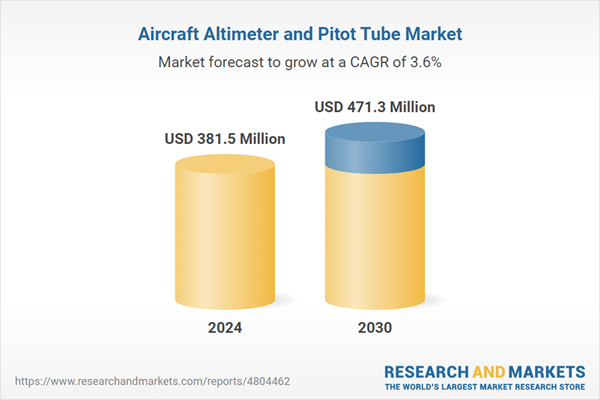The global market for Aircraft Altimeter and Pitot Tube was valued at US$381.5 Million in 2024 and is projected to reach US$471.3 Million by 2030, growing at a CAGR of 3.6% from 2024 to 2030. This comprehensive report provides an in-depth analysis of market trends, drivers, and forecasts, helping you make informed business decisions. The report includes the most recent global tariff developments and how they impact the Aircraft Altimeter and Pitot Tube market.
Segments: End-Use (Narrow-Body Aircraft, Wide-Body Aircraft, Regional Aircraft).
Geographic Regions/Countries: World; United States; Canada; Japan; China; Europe (France; Germany; Italy; United Kingdom; Spain; Russia; and Rest of Europe); Asia-Pacific (Australia; India; South Korea; and Rest of Asia-Pacific); Latin America (Argentina; Brazil; Mexico; and Rest of Latin America); Middle East (Iran; Israel; Saudi Arabia; United Arab Emirates; and Rest of Middle East); and Africa.
The analysts continuously track trade developments worldwide, drawing insights from leading global economists and over 200 industry and policy institutions, including think tanks, trade organizations, and national economic advisory bodies. This intelligence is integrated into forecasting models to provide timely, data-driven analysis of emerging risks and opportunities.
Global Aircraft Altimeter and Pitot Tube Market - Key Trends and Drivers Summarized
What Are Aircraft Altimeters and Why Are They Essential?
Aircraft altimeters are vital instruments that measure an aircraft's altitude above sea level, providing crucial data for safe and accurate navigation. There are primarily two types of altimeters used in aviation: barometric and radar altimeters. Barometric altimeters measure altitude by comparing the current atmospheric pressure with the standard atmospheric pressure at sea level, using the principle that air pressure decreases with height. This type of altimeter is standard in most aircraft, providing pilots with a crucial reference for flight levels and ensuring proper separation from other aircraft and terrain. Radar altimeters, on the other hand, measure the exact distance between the aircraft and the ground by bouncing a radar signal off the surface below, making them particularly useful during landing and low-altitude flight operations. Altimeters are essential for maintaining safe flight levels, especially in low visibility conditions or when navigating complex airspace. Their accuracy and reliability are critical, as even small errors can lead to significant altitude deviations, potentially compromising flight safety.How Do Pitot Tubes Function and Why Are They Important in Aviation?
Pitot tubes are another crucial component in an aircraft's instrumentation system, specifically used to measure airspeed. The device operates on the principle of differential pressure, capturing the dynamic pressure of the airflow (impact pressure) and comparing it with the static pressure (ambient air pressure). This difference allows the calculation of the aircraft's airspeed, which is displayed on the airspeed indicator. Accurate airspeed readings are essential for pilots to maintain control of the aircraft, ensuring that it is neither too fast, which can lead to structural stress, nor too slow, which can result in a stall. Pitot tubes are typically mounted on the aircraft's exterior, where they can sample airflow unimpeded by the aircraft's body. The importance of pitot tubes extends beyond just measuring airspeed; they also provide critical input for the aircraft's flight management systems, including autopilot functions and performance monitoring systems. Ensuring the accuracy and functionality of pitot tubes is crucial, as any blockages or malfunctions can lead to incorrect airspeed readings, posing serious risks to flight safety.What Challenges and Opportunities Exist in the Aircraft Altimeter and Pitot Tube Market?
The market for aircraft altimeters and pitot tubes is characterized by a mix of challenges and opportunities, driven by technological advancements and evolving regulatory requirements. One of the primary challenges is the need for enhanced accuracy and reliability in altimeters, particularly as aircraft fly at increasingly high altitudes and operate in diverse environmental conditions. This challenge is compounded by the need for regular maintenance and calibration to ensure that these instruments provide accurate readings. Similarly, pitot tubes are susceptible to blockages from ice or debris, which can compromise their functionality and lead to erroneous data. However, these challenges also present opportunities for innovation. The development of advanced materials and heating systems for pitot tubes has enhanced their reliability and reduced the risk of blockages. In the realm of altimeters, advancements in laser and GPS-based systems are providing alternatives to traditional barometric measurements, offering greater precision and resilience against environmental variations. Additionally, the increasing integration of these systems with digital avionics and flight management systems enhances their functionality and ease of use, presenting significant growth potential for manufacturers.What Drives the Growth in the Aircraft Altimeter and Pitot Tube Market?
The growth in the aircraft altimeter and pitot tube market is driven by several factors, including technological advancements, regulatory mandates, and the expanding global aviation sector. Technological innovations, such as the development of digital and laser altimeters, have improved the accuracy and reliability of altitude measurements, making these instruments more attractive to aircraft manufacturers and operators. The introduction of advanced heating systems and more durable materials for pitot tubes has similarly enhanced their reliability, reducing the risk of blockages and associated safety hazards. The growing complexity of modern aircraft and the increasing demand for enhanced safety systems are also driving the adoption of more sophisticated altimeter and pitot tube technologies. Regulatory requirements mandating regular maintenance and calibration of these instruments to ensure flight safety are further supporting market growth. Additionally, the expansion of the commercial aviation sector, particularly in emerging markets, is creating increased demand for reliable and advanced flight instrumentation. The rising popularity of unmanned aerial vehicles (UAVs) and the ongoing development of next-generation aircraft technologies are also contributing to the growth of this market, as these platforms require precise altitude and airspeed data for safe operation.Report Scope
The report analyzes the Aircraft Altimeter and Pitot Tube market, presented in terms of units. The analysis covers the key segments and geographic regions outlined below.Segments: End-Use (Narrow-Body Aircraft, Wide-Body Aircraft, Regional Aircraft).
Geographic Regions/Countries: World; United States; Canada; Japan; China; Europe (France; Germany; Italy; United Kingdom; Spain; Russia; and Rest of Europe); Asia-Pacific (Australia; India; South Korea; and Rest of Asia-Pacific); Latin America (Argentina; Brazil; Mexico; and Rest of Latin America); Middle East (Iran; Israel; Saudi Arabia; United Arab Emirates; and Rest of Middle East); and Africa.
Key Insights:
- Market Growth: Understand the significant growth trajectory of the Narrow-Body Aircraft End-Use segment, which is expected to reach US$235.4 Million by 2030 with a CAGR of a 4.0%. The Wide-Body Aircraft End-Use segment is also set to grow at 3.3% CAGR over the analysis period.
- Regional Analysis: Gain insights into the U.S. market, valued at $102.5 Million in 2024, and China, forecasted to grow at an impressive 6.1% CAGR to reach $96.0 Million by 2030. Discover growth trends in other key regions, including Japan, Canada, Germany, and the Asia-Pacific.
Why You Should Buy This Report:
- Detailed Market Analysis: Access a thorough analysis of the Global Aircraft Altimeter and Pitot Tube Market, covering all major geographic regions and market segments.
- Competitive Insights: Get an overview of the competitive landscape, including the market presence of major players across different geographies.
- Future Trends and Drivers: Understand the key trends and drivers shaping the future of the Global Aircraft Altimeter and Pitot Tube Market.
- Actionable Insights: Benefit from actionable insights that can help you identify new revenue opportunities and make strategic business decisions.
Key Questions Answered:
- How is the Global Aircraft Altimeter and Pitot Tube Market expected to evolve by 2030?
- What are the main drivers and restraints affecting the market?
- Which market segments will grow the most over the forecast period?
- How will market shares for different regions and segments change by 2030?
- Who are the leading players in the market, and what are their prospects?
Report Features:
- Comprehensive Market Data: Independent analysis of annual sales and market forecasts in US$ Million from 2024 to 2030.
- In-Depth Regional Analysis: Detailed insights into key markets, including the U.S., China, Japan, Canada, Europe, Asia-Pacific, Latin America, Middle East, and Africa.
- Company Profiles: Coverage of players such as AeroControlex Group, Aerosonic Corporation, Collins Aerospace, Committee for Aviation and Space Industry Development (CASID), Dynon Avionics and more.
- Complimentary Updates: Receive free report updates for one year to keep you informed of the latest market developments.
Some of the 47 companies featured in this Aircraft Altimeter and Pitot Tube market report include:
- AeroControlex Group
- Aerosonic Corporation
- Collins Aerospace
- Committee for Aviation and Space Industry Development (CASID)
- Dynon Avionics
- EXP Aircraft Services
- FreeFlight Systems
- Froch Enterprise Co., Ltd.
- Garrecht Avionik GmbH (AIR Avionics)
- Honeywell International, Inc.
Tariff Impact Analysis: Key Insights for 2025
Global tariff negotiations across 180+ countries are reshaping supply chains, costs, and competitiveness. This report reflects the latest developments as of April 2025 and incorporates forward-looking insights into the market outlook.The analysts continuously track trade developments worldwide, drawing insights from leading global economists and over 200 industry and policy institutions, including think tanks, trade organizations, and national economic advisory bodies. This intelligence is integrated into forecasting models to provide timely, data-driven analysis of emerging risks and opportunities.
What’s Included in This Edition:
- Tariff-adjusted market forecasts by region and segment
- Analysis of cost and supply chain implications by sourcing and trade exposure
- Strategic insights into geographic shifts
Buyers receive a free July 2025 update with:
- Finalized tariff impacts and new trade agreement effects
- Updated projections reflecting global sourcing and cost shifts
- Expanded country-specific coverage across the industry
Table of Contents
I. METHODOLOGYII. EXECUTIVE SUMMARY2. FOCUS ON SELECT PLAYERSIII. MARKET ANALYSISIV. COMPETITION
1. MARKET OVERVIEW
3. MARKET TRENDS & DRIVERS
4. GLOBAL MARKET PERSPECTIVE
UNITED STATES
CANADA
JAPAN
CHINA
EUROPE
FRANCE
GERMANY
ITALY
UNITED KINGDOM
SPAIN
RUSSIA
REST OF EUROPE
ASIA-PACIFIC
AUSTRALIA
INDIA
SOUTH KOREA
REST OF ASIA-PACIFIC
LATIN AMERICA
ARGENTINA
BRAZIL
MEXICO
REST OF LATIN AMERICA
MIDDLE EAST
IRAN
ISRAEL
SAUDI ARABIA
UNITED ARAB EMIRATES
REST OF MIDDLE EAST
AFRICA
Companies Mentioned (Partial List)
A selection of companies mentioned in this report includes, but is not limited to:
- AeroControlex Group
- Aerosonic Corporation
- Collins Aerospace
- Committee for Aviation and Space Industry Development (CASID)
- Dynon Avionics
- EXP Aircraft Services
- FreeFlight Systems
- Froch Enterprise Co., Ltd.
- Garrecht Avionik GmbH (AIR Avionics)
- Honeywell International, Inc.
Table Information
| Report Attribute | Details |
|---|---|
| No. of Pages | 188 |
| Published | April 2025 |
| Forecast Period | 2024 - 2030 |
| Estimated Market Value ( USD | $ 381.5 Million |
| Forecasted Market Value ( USD | $ 471.3 Million |
| Compound Annual Growth Rate | 3.6% |
| Regions Covered | Global |









